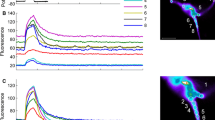Summary
-
1.
Nerve impulses from the afferent fibre of the ampullary electroreceptor inIctalurus were recorded and changes of the response characteristics induced by calcium ions in the medium surrounding the fish were examined.
-
2.
Under normal calcium concentration (2 mM/1) set and break of long lasting electrical stimuli lead to frequency changes, which are equal in size (and have opposite direction) for anodal and cathodal currents, respectively. With calcium deficiency only anodal currents evoke a response (Fig. 1).
-
3.
Also in the case of low calcium, responses to intensity steps depend on direct current flow, but are largely unaffected by the d.c.-level under normal and high calcium (Fig. 3).
-
4.
The decline of the frequency response does not alter the height of a succeeding response, and the off-response is fullsized already at the beginning of frequency decline. The response to the second current-step is only influenced by a preceding current onset, if the interval is shorter than 50–90 ms. For longer delays the frequency response is the same as a reaction unaffected by a prestimulus (Figs. 4–6). This time dependent decrease of the prestimulus effect is not seen with low calcium: there is a permanent (sensitivity enhancing) effect of direct current flow (Fig. 7).
-
5.
From these results it has become evident that the differentiating operation mode of the ampullary electroreceptor is based on two different processes: (1) a calcium dependent mechanism, which makes the receptor independent of direct current and (2) the decline of the frequency response during continuous current flow which is not affected by calcium ions.
Similar content being viewed by others
References
Bennett, M.V.L.: Electroreceptors in mormyrids. Cold Spr. Harb. Symp. quant. Biol.30, 245–262 (1965)
Bennett, M.V.L.: Electroreception. In: Fish physiology, Vol. V (eds. W.S. Hoar, D.J. Randall), pp. 493–574. New York-London: Academic Press 1971
Burkhardt, D.: Die Eigenschaften und Funktionstypen der Sinnesorgane. Ergebn. Biol.22, 227–267 (1960)
Burkhardt, D.: Wörterbuch der Neurophysiologie. Jena: VEB Gustav Fischer 1971
Clusin, W., Spray, D.C., Bennett, M.V.L.: Activation of a voltage-insensitive conductance by inward calcium current. Nature (Lond.)256, 425–427 (1975)
Clusin, W.T., Bennett, M.V.L.: Calcium electrogenesis in skate electroreceptor. Biol. Bull.145, 429 (1973)
Husmark, L., Ottoson, D.: The contribution of mechanical factors to the early adaptation of the spindle response. J. Physiol. (Lond.)212, 577–592 (1971a)
Husmark, I., Ottoson, D.: Ionic effects on spindle adaptation. J. Physiol. (Lond.)218, 257–270 (1971b)
Katsuki, Y., Hashimoto, T., Yanagisawa, K.: The lateral-line organ of shark as a chemoreceptor. Advanc. Biophys.1, 1–51 (1970)
Mendelson, M., Loewenstein, W.R.: Mechanisms of receptor adaptation. Science144, 554–555 (1964)
Obara, S.: Calcium dependent receptor potential of the elctroreceptor of marine catfish. Proc. Japan. Acad.50, 247–251 (1974)
Peters, R.C., Bretschneider, F., Schreuder, J.-J.A.: Influence of direct current stimulation on the ion-induced sensitivity changes of the electroreceptors (small pit organs) of the brown bullhead,Ictalurus nebulosus LeS. Netherlands J. Zool.25, 389–397 (1975)
Peters, R.C., Buwalda, R.J.A.: Frequency response of the electroreceptors (“small pit organs”) of the catfishIctalurus nebulosus LeS. J. comp. Physiol.79, 29–38 (1972)
Roth, A.: Electroreception in catfishAmiurus nebulosus. Z. vergl. Physiol.61, 196–202 (1968)
Roth, A.: Elektrische Sinnesorgane beim ZwergwelsIctalurus nebulosus (Amiurus nebulosus). Z. vergl. Physiol.65, 368–388 (1969)
Roth, A.: Zur Funktionsweise der Elektrorezeptoren in der Haut von Welsen (Ictalurus): Der Einfluß der Ionen im Süßwasser. Z. vergl. Physiol.75, 303–322 (1971)
Roth, A.: Wozu dienen die Elektrorezeptoren der Welse? J. comp. Physiol.79, 113–135 (1972)
Sand, O.: Effects of different ionic environments on the mechanosensitivity of lateral line organs in the mudpuppy. J. comp. Physiol.102, 27–42 (1975)
Sand, O., Ozawa, S., Hagiwara, S.: Electrical and mechanical stimulation of the hair cells in the mudpuppy. J. comp. Physiol.102, 13–26 (1975)
Steinbach, A.B., Bennett, M.V.L.: Effects of divalent ions and drugs on the synaptic transmission in phasic electroreceptors in mormyrid fish. J. gen. Physiol.58, 580–598 (1971)
Zhadan, G.G., Zhadan, P.M.: Effects of sodium, potassium and calcium ions on the functional characteristics of the catfish electroreceptors. Neurophysiol. (Kiew)7, 403–410 (1975)
Author information
Authors and Affiliations
Additional information
Supported by a grant from the Deutsche Forschungsgemeinschaft given to Dr. A. Roth
I.am very indebted to Dr. A. Roth who made this work possible, and to Dr. E.-A. Seyfarth and Prof. Dr. C. Nicholson for critical comments on the manuscript.
Rights and permissions
About this article
Cite this article
Bauswein, E. Effect of calcium on the differentiating operation of the ampullary electroreceptor inIctalurus nebulosus . J. Comp. Physiol. 121, 381–394 (1977). https://doi.org/10.1007/BF00613016
Received:
Issue Date:
DOI: https://doi.org/10.1007/BF00613016



